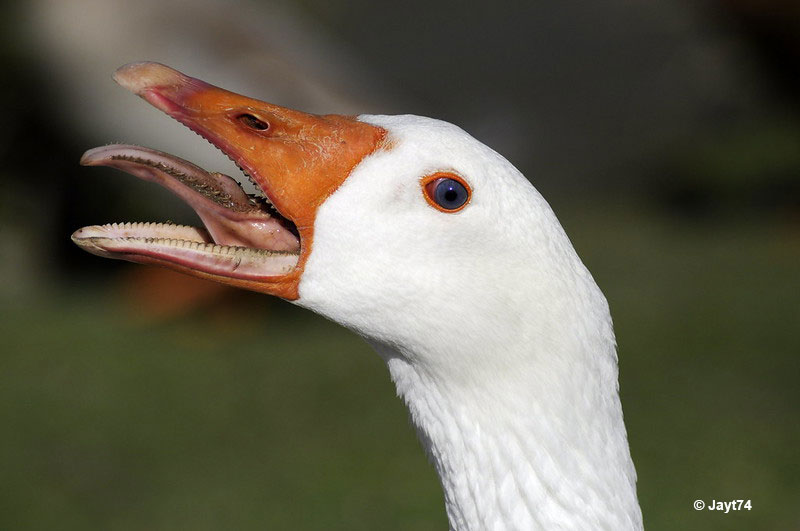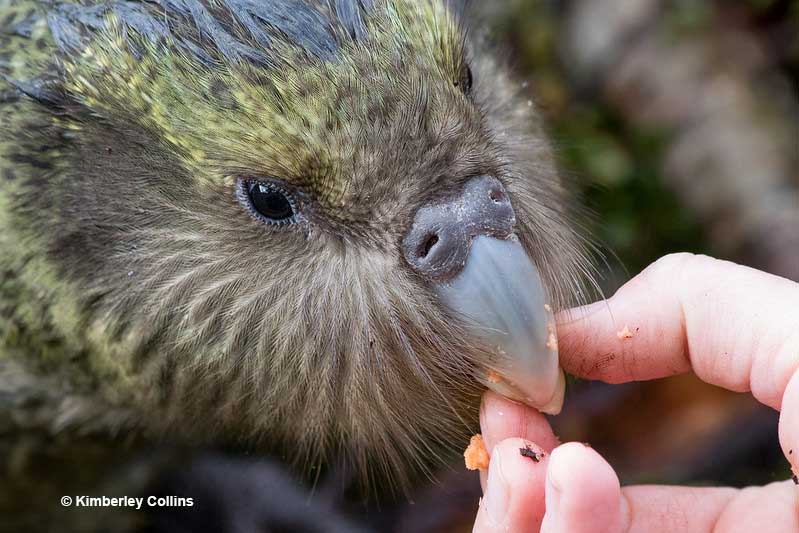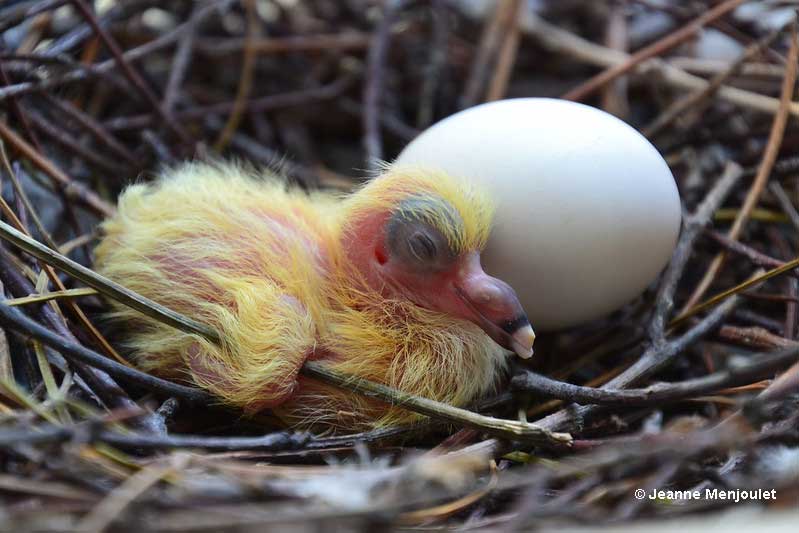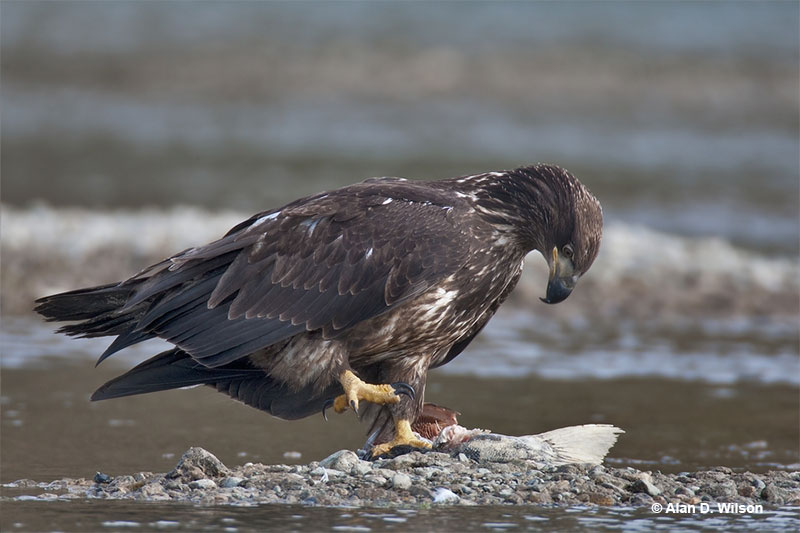
Birds are fascinating creatures renowned for their diverse forms, behaviors, and environmental adaptations. They come in all shapes and sizes, from the tiny hummingbirds to the mighty eagles. While we often associate them with beaks, not all birds possess the same anatomy.
So, do birds have teeth? Some species have noticeable serrations, but these are often considered to be part of their bills. But are there any species that actually have teeth? Keep reading to find out!
On this page
Do Birds Have Teeth?
Birds, for the most part, do not have teeth in the same way that mammals do. Most bird species have evolved to rely on beaks, which come in various shapes and sizes, adapted to their specific dietary needs. While most birds have toothless beaks, there are a few intriguing exceptions.

Kākāpō. © Kimberley Collins
One such example is the Kākāpō, a critically endangered parrot native to New Zealand. Kākāpōs are unique because they have evolved small, backward-pointing “teeth” on their beaks, which help them chew tougher plant materials and seeds.
Geese are another species that are thought to have teeth, but these are just serrations, helping them to chew plant matter.
How Do Birds Break Down Their Food?
Birds have evolved a remarkable range of techniques to break down their food, depending on their dietary preferences. Here are a few examples:
- Beak Structure: The shape and structure of a bird’s beak are tailored to its diet. For instance, the long, slender beak of a hummingbird is perfectly adapted for sipping nectar from flowers, while the powerful hooked beak of a raptor, like the Bald Eagle, is designed to tear into meat.
- Crop and Gizzard: Birds have a unique digestive system that includes a crop and a gizzard. The crop is an enlarged pouch in the throat where food is temporarily stored, and the gizzard is a muscular portion of the stomach that grinds down food using small stones or grit the bird ingests. This grinding action helps break down tough plant material or the exoskeletons of insects.
- Regurgitation: Some birds, such as pigeons and doves, feed their chicks a milky substance produced in their crop, a process known as crop milk. After digesting this nutrient-rich material, they regurgitate it to feed their young.
The Egg Tooth
The egg tooth is a small, pointed projection located near the tip of a bird’s beak. It is present in some bird species and is used by hatchlings to help them break free from their eggshells. The egg tooth is a temporary structure and is absorbed or falls off shortly after hatching.

This newly-hatched pigeon still has its egg tooth
Not all bird species have an egg tooth. It is more common in birds that lay hard-shelled eggs, such as chickens and many reptiles. The egg tooth is a tiny but vital tool for hatchlings, allowing them to make a small crack in the eggshell before eventually pushing their way out.
As birds mature, the egg tooth serves no further purpose and is lost or absorbed. In species like chickens, the egg tooth is typically gone within a day or two after hatching, making way for the development of their adult beaks.
Interesting Facts About Birds And Their “Teeth”
- The Tooth-billed Pigeon, native to Samoa, has a beak with serrated edges that resemble teeth, giving it its unique name.
- Birds are modern-day descendants of theropod dinosaurs, many of which had sharp, serrated teeth. Although most birds lost these teeth over time, some, like Kākāpō, have developed tooth-like features on their beaks.
- Hornbills have a specialized bill that allows them to grind their food into smaller pieces. They often feed on fruits, insects, and small animals.
- Pelicans, known for their enormous beaks, have pouches that help them scoop up fish. Their serrated beak edges also assist in grasping slippery prey.
- Parrots possess strong, hooked beaks that enable them to crack open tough nuts and seeds.
- Flamingos use their specialized beaks to filter tiny aquatic organisms from the water, employing a comb-like structure known as lamellae to strain their food.
- Toucans, with their distinctive large bills, use them to reach fruit on tree branches that are otherwise inaccessible. Their beaks are designed for grasping and manipulating fruit.
- Hummingbirds have long, needle-like bills that allow them to probe deep into flowers for nectar, with specialized tongues for efficient feeding.
- Woodpeckers have beaks designed like chisels, which they use to drill into tree bark in search of insects. Then, their tongue will flick into the cavity, catching the insects.
- Puffins have serrated beaks that help them grasp multiple small fish at once. They can hold a considerable amount of food within the grooves of their beaks.
The Evolution of Bird Teeth
Birds are descendants of theropod dinosaurs, many of which had sharp, serrated teeth. However, over millions of years, as birds adapted, they underwent significant transformations in their oral anatomy. The evolution of beaks in place of teeth allowed for more efficient and specialized feeding strategies.
Fossil evidence suggests that early birds had teeth, much like their dinosaur ancestors. These teeth were useful for capturing and tearing prey.

Birds of prey use their talons and bill, ripping off pieces of meat.
Over time, many bird lineages began to lose their teeth, likely due to the advantages of lighter skulls and reduced energy expenditure in maintaining teeth. Tooth loss also allowed for the development of beaks better suited to various diets.
The evolution of beaks became a crucial adaptation. Beak shapes and sizes diversified, giving rise to specialized beaks for crushing, probing, grasping, or tearing.
The development of the crop, an enlarged pouch in the throat, became essential for temporary food storage and digestion in birds. Combined with the gizzard, a muscular portion of the stomach, this system allowed birds to process a wide range of food types efficiently.
Frequently Asked Questions
What is the only bird with teeth?
The Kākāpō, a rare and critically endangered parrot native to New Zealand, is the only known bird species with backward-pointing “teeth” on its beak.
Do ducks have teeth?
Ducks do not have teeth. Instead, they have serrations along the edges of their beaks, which help them filter food from the water. Their diet consists of aquatic plants, small invertebrates, and crustaceans.
Does the swan have teeth?
Swans also lack actual teeth. They use their beaks to grasp aquatic plants and small aquatic animals, such as insects, but do not have the teeth found in mammals.
Do chickens have teeth?
Chickens do not have teeth as adults. However, they have a small, temporary egg tooth on their beak when they hatch, which is used to crack open their eggshells. This egg tooth disappears shortly after hatching.
Do penguins have teeth?
Penguins, like most birds, do not have teeth. Instead, they have backward-pointing spines in their throats that help them grip and swallow their prey whole. They primarily feed on fish and squid.
Do birds have tongues?
Yes, birds do have tongues, but the structure varies among species. The tongues of birds are adapted to their specific diets. Some bird species have long, specialized tongues for nectar feeding, while others have simpler, shorter tongues for capturing and manipulating food.

